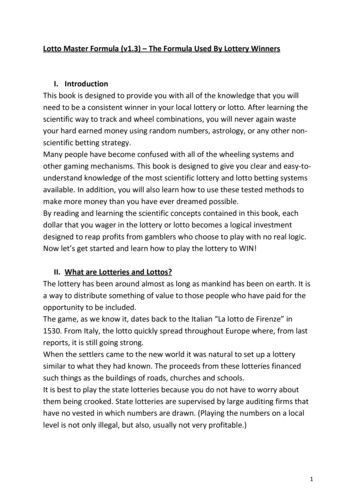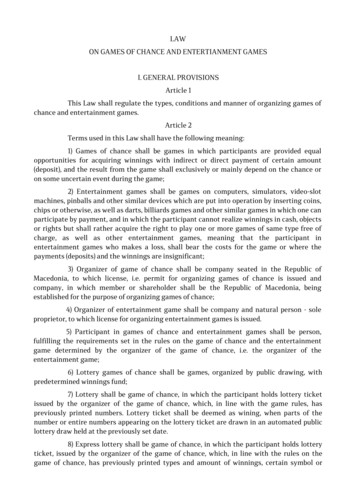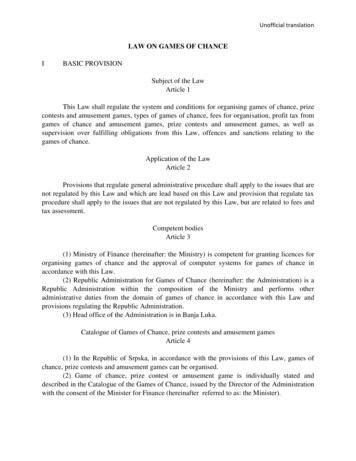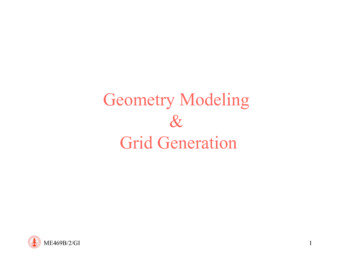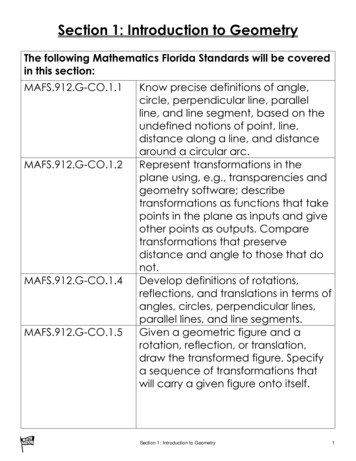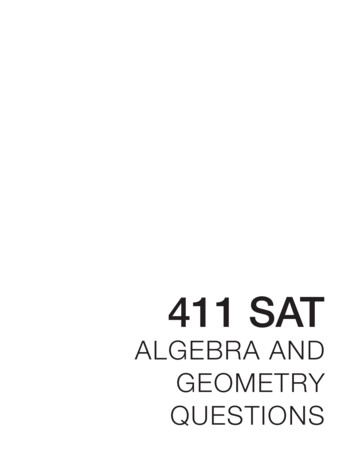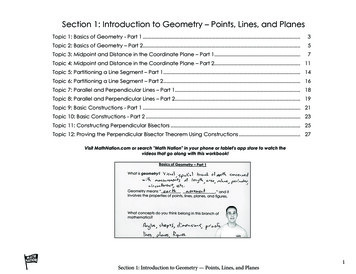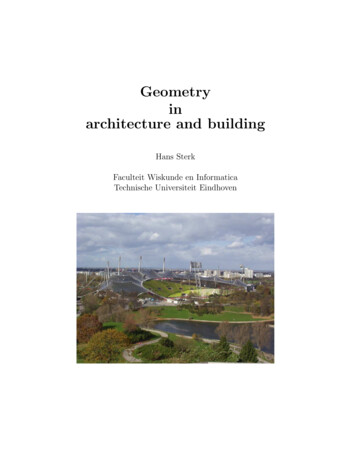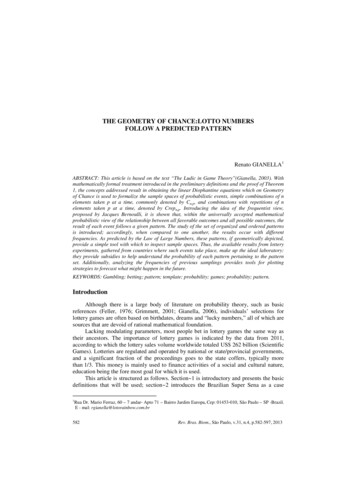
Transcription
THE GEOMETRY OF CHANCE:LOTTO NUMBERSFOLLOW A PREDICTED PATTERNRenato GIANELLA1ABSTRACT: This article is based on the text “The Ludic in Game Theory”(Gianella, 2003). Withmathematically formal treatment introduced in the preliminary definitions and the proof of Theorem1, the concepts addressed result in obtaining the linear Diophantine equations which on Geometryof Chance is used to formalize the sample spaces of probabilistic events, simple combinations of nelements taken p at a time, commonly denoted by Cn,p, and combinations with repetitions of nelements taken p at a time, denoted by Crepn,p. Introducing the idea of the frequentist view,proposed by Jacques Bernoulli, it is shown that, within the universally accepted mathematicalprobabilistic view of the relationship between all favorable outcomes and all possible outcomes, theresult of each event follows a given pattern. The study of the set of organized and ordered patternsis introduced; accordingly, when compared to one another, the results occur with differentfrequencies. As predicted by the Law of Large Numbers, these patterns, if geometrically depicted,provide a simple tool with which to inspect sample spaces. Thus, the available results from lotteryexperiments, gathered from countries where such events take place, make up the ideal laboratory:they provide subsidies to help understand the probability of each pattern pertaining to the patternset. Additionally, analyzing the frequencies of previous samplings provides tools for plottingstrategies to forecast what might happen in the future.KEYWORDS: Gambling; betting; pattern; template; probability; games; probability; pattern.IntroductionAlthough there is a large body of literature on probability theory, such as basicreferences (Feller, 1976; Grimmett, 2001; Gianella, 2006), individuals’ selections forlottery games are often based on birthdates, dreams and “lucky numbers,” all of which aresources that are devoid of rational mathematical foundation.Lacking modulating parameters, most people bet in lottery games the same way astheir ancestors. The importance of lottery games is indicated by the data from 2011,according to which the lottery sales volume worldwide totaled US 262 billion (ScientificGames). Lotteries are regulated and operated by national or state/provincial governments,and a significant fraction of the proceedings goes to the state coffers, typically morethan 1/3. This money is mainly used to finance activities of a social and cultural nature,education being the fore most goal for which it is used.This article is structured as follows. Section 1 is introductory and presents the basicdefinitions that will be used; section 2 introduces the Brazilian Super Sena as a case1Rua Dr. Mario Ferraz, 60 – 7 andar‐ Apto 71 – Bairro Jardim Europa, Cep: 01453‐010, São Paulo – SP -Brazil.E - mal: rgianella@lotorainbow.com.br582Rev. Bras. Biom., São Paulo, v.31, n.4, p.582-597, 2013
study lottery; in section 3, the concept of a template, i.e., a betting pattern, is introduced inaddition to various facts related to it; section 4 shows the reader how to improve his betsbased on the facts presented on templates; and section 5 presents the conclusions.JustificationThe notion of chance dates from the Egyptian civilization. Probability theory is oftenfound in close relationship with gambling in the studies of Cardano, Galileo, Pascal,Fermat and Huygens. From the solution of the “problem of points,” the nature ofgambling was first seen as a mathematical structure. The game was a mathematical model,analogous to an equation or a function. The frequentist notion, as proposed by JacquesBernoulli in 1713 in a classical work, approximates the probability of a given event by thefrequency observed when the experiment is repeated a significant number of times. Withrespect to the formal concept of probability, throughout mathematical history, there hasbeen great difficulty in the choice of a model that expresses the connection between theideal and real worlds. Through the concept of a template, games/bets are classified intopatterns. The model presented here, based on the Law of Large Numbers, illustratesknowledge of the geometric organization of discrete sample spaces, which have gainedfrom behavior patterns with preset theoretical probabilities. By deducing differentbehaviors, it enables the use of knowledge of the future in decision-making. The Brazilianlottery game known as Super Sena is used as our case study.Preliminary definitionsWe denote the set of natural numbers{0, 1, 2, }by ℕ and the set {1, 2, 3, }byℕ*. We denote the set of real numbers by ℛ.Let n and p be real numbers such that n . Let M {a1, a2, , an}. The number ofcombinations of the elements of M taken p by p and represented by Cn,p is given byCn,p !! !.Using the same n and p, the number of combinations of the elements of N taken p byp with repetition and represented by Crepn,p is given byCrepn,p Cn p-1,p.Let A be a set and A1, , An sets with n 1. We say that (A1, , An) is a cover for A ifA A1 2 n.Let A be a set and (A1, , An) with n 1 be a cover for A. We say that (A1, , An) is apartition ofA ifA A1 2 n and Ai Aj , , 1 , .Let A, B ℕ with!inite. A coloring of A with colors of B is a function c : A B.We say that the elements of B are colors. Let c be a coloring of A with colors from B, andlet Im(c) {c0, c2, , ck}.We say that A was colored with colors c0, c2, , ck.Rev. Bras. Biom., São Paulo, v.31, n.4, p.582-597, 2013583
Let Ei such that c(e) ci Ei.We say that Ei is colored with color ci or that Ei has color ci.A finite probability space is comprised of a finite set Ω together with a functionP:Ω ℛ such that ω Ω, P(ω 0 and . Ω - ω 1.The set Ω is the sample space, and the function P is the distribution of probabilitiesover. Ω. The elements ω Ω are called basic events. An event is a subset of Ω.Let Ω be a sample space and P be a distribution of probabilities. We define theprobability function or, simply, the probability over Ω as being the function Pr : Ω ℛ such that:Pr(A): 0 1 - 2 , 3.We note that, by definition, Pr({ω} - ω , Pr( 0 and Pr(Ω 1.Trivial events are those with a probability of 0 and 1, that is, the events and Ω,respectively. Throughout in this paper, we also denote probabilities by percentages.The uniform distribution over the sample space 3 is defined by settingPr(2 1/ 3 For all ω Ω. Based on this distribution, we obtain the uniform probability space over Ω.By definition, we note that, in a uniform probability space, for any eventA Ω, Pr(A) / Ω .The definition of a uniform probability space is a formalization of the notion of“fair,” as in the case of “fair dice.”All of the faces of a fair die have an equal probabilityoutcome.Let the equation x1 x2 xr n with x1, x2, ,xr and n natural numbers. Thisequation is a particular case of diophantine equations. We know from number theory thatthe possible number of natural solutions for this equation is Cn r-1,r.Let n and p be natural numbers with n .We say that a lottery is p/n if p numbersare drawn(without repetition) from the set Sn: {1, 2, , n}.Each subset consisting of pdrawn numbers is called a game or bet. We denote these by p-uples in increasing order.2.Case Study: Brazilian Super SenaWe begin our study with the Brazilian Super Sena, which was operated by CaixaEconômica Federal (a bank controlled by the Brazilian government)from 1995 to 2001[4,5]. We could use any p/n lottery; however, we decided to study an existing lottery witha “large” number of drawings to compare the probabilities of certain events with theobserved frequencies.Super Sena is a 6/48 lottery; thus, the number of possible bets is given by:;!C48,6 ! :; ! 12.271.512 .Moreover, because Super Sena is fair, the setΩ of possible 12.271.512 bets is asample space; together with the function P(ω 1/12.271.512, ω Ω is a uniformprobability space.In the following, instead of considering the numbers of S48, we consider each groupof 10numbers as follows:584Rev. Bras. Biom., São Paulo, v.31, n.4, p.582-597, 2013
Di : {i* 10 j tal que 0 9} para0 3 and D4: {40, , 48}.Clearly, (D0, D1, D2, D3, D4) is a partition of S48.Let B : {c0, ,c4} be a set of colors such that c0 c1 c2 c3 c4, and letc: S48 Bsuch that c(k): ci if and only if k Di 0 i 4.We can say that Di has color ci for i {0, , 4}, or intuitively, each group of 10numbers of Super Sena has its own color.Hereafter, let us concentrate on the colors of the bets. A template Tgo, ,gn is anordered(n 1) t-uple of colors (g0, g1, ,gn) such thatg0 g1 gn and gi { g0, g1, ,gn },0 .We say that n 1 is the size of the template. Because Super Sena is a 6/48 lotteryand we have 5possible groups of 10 numbers, every template has size 6 and containsat least 1color, which appears more than once. Hereafter, we consider templates ofsize 6 only.We can establish a membership relation of bets with colors in the following way. Let(a0, a1, a2,a3,a4, a5) be a bet, and let Tgo, ,g5 be a template.(a0, a1, a2, a3,a4, a5) Ggo, ,g5if and only if c(ai) gi, 0 5.A template Ggo, ,g5 is said to be monochromatic if g0 g1 g2 g3 g4 g5.The following theorem provides us with important information regarding templates.Theorem 1.The number of possible templates of Super Sena is 210.Proof. Let us recall that in Super Sena we draw (without replacement) 6 numbers from5groups of 10 numbers (colors). Let us consider an arbitrary template Tgo, ,g5. Let xi thenumber of times that the color ci appears in (g0, g1, g2, g3,g4, g5), for 0 i 4.Because1ofthe colors obligatorily appears more than once, we can write the following diophantineequationx0 x1 x2 x3 x4 6That is, there is at least 1color that contributes 2 in the above sum. As presented inthe section of preliminary definitions, from number theory, we have that the number ofnatural solutions for this equation is C6 5-1,5-1 C10,4 210. Intuitively, each of these 210 templates provides us with a “way” of betting: these“ways” of betting are given by the color of the templates. In the next section, wecategorize several templates according to their colors and probabilities of occurrence.In the following, we present an alternative version of the proof of Theorem 1through a geometric method, illustrating the idea on which this paper is focused.Alternative proof of Theorem 1.Weagain draw (without replacement) 6 numbers from5groups)(colors) of 10numbers. Let us consider an arbitrary template Ggo, ,g5. Let xi number of times that the color ci appears in (g0, g1, g2, g3,g4, g5), for 0 i 4.Because1ofthe colors obligatorily appears more than once, we can write the following diophantineequationRev. Bras. Biom., São Paulo, v.31, n.4, p.582-597, 2013585
x0 x1 x2 x3 x4 6That is, there is at least 1 color that contributes 2 in the above sum.Because the sum is 6, we draw 6 squares with traces.1234567How many traces are need to divide 5 integers?Because there are 5 integer numbers (x0x1x2x3 x4), we use 4 dividing traces torepresent a solution to the equation. Thus, p 4.How many positions to put traces in 6 spaces?To establish the possible positions for the traces in 6 spaces, we have n 7.How many ways ( distinct or not ) can be chosen to put 4 separatory traces in 7distinct positions?Therefore,Crep7,4 C7 4-1,4 210 (Trotta, 1988). 2.1Categorization of TemplatesIn the following, let us write a table of all 210 templates. First, let us recall that atemplate Tgo, ,gn is an ordered (n 1)-tuple of colors (g0, g1, ,gn) such that g0 g1 gnand gi {c0,c1, ,cn},0 i n. In the case of Super Sena, n is 5, that is, colors c0,c1, c2, c3andc4. We present Table 1with all 210 templates in the Appendix. Table 1 was written indecreasing order of template probability.We present some facts regarding Table 1.The following theorem can be proved by counting the templates in Table 1, or it canbe proved by computing the combinations. This gives the probability of monochromatictemplates.Theorem 2.Monochromatic templates of colors c0 and c4havea 0.0007% probability ofoccurring.Proof. Let us recall that each color in {c0,c4}colors 9 numbers. Without loss of generality,let us consider color c0and compute the probability of occurrence of template Tc0, ,c0. Theprobability of having color c0in 6 spaces is C9,6 84.Because the probability of occurrenceof the templates is uniform, the probability of occurrence of a monochromatic templateis84/12.271.512 0.0000068,or 0.00068%,which we approximate to 0.0007%. The sameargument works for c4. 586Rev. Bras. Biom., São Paulo, v.31, n.4, p.582-597, 2013
The following theorem is also presented for monochromatic templates.Theorem 3.Monochromatic templates of colors c1, c2, andc3 have probabilities ofoccurrence of 0.0017%.Proof. Let us recall that each color in {c1, c2, c3}colors 10 numbers. Without loss ofgenerality, let us consider color c1 and compute the probability of occurrence of templateTc1, ,c1. The probability of having color c1in 6 spaces is C10,6 210.Because the probabilityof occurrence of the templates is uniform, the probability of occurrence of amonochromatic template is210/12.271.512 0.0000171,or 0.00171%,which weapproximate to 0.0017%. The same argument works for c2andc3. Although monochromatic templates have very low probabilities of occurrence, weobserve from both theorems above that the probability of occurrence of monochromatictemplates with colors c1, c2andc3(0.00171%) is more than double the probability ofoccurrence of monochromatic templates with colors c0 andc4 (0.0007%).We present more facts regarding Table 1.Fact 1.Each template has an exact number of combinations, and the sum of thecombinations of all templates is the same as that given by the formula C48,6 48!/(486)!6!.Fact 2.Dividing the total number of outcomes favorable to each template by the totalnumber of possible outcomes yields, a priori and exactly, the probability of each.Fact 3.The 210 templates can be split into 39 groups with different probabilities.Fact 4.The templates recurring most often (group 1), i.e., the templates with higherprobabilities of occurrence, have little less than 3% chance, i.e., they occur 3 times every100draws, while those from group 39, with 0.0007% chance, occur 7 times every1,000,000 draws.Fact 5.Each of the first 35 templates has a probability between 3% and 1%; together, theyrepresent approximately 50%, while the remaining 175 templates make up the other 50%.Table 1 can be rewritten so that we can obtain more information on the behavior ofbets.1.First, we write all templates with color c0 in the first position.2.Next, we write all templates with color c0in the first and in the second positiononly.3.We apply the same reasoning to the first 3 position and then to the first 4positions, until we obtain a unique template at the end with 6 colored (c0)positions.Rev. Bras. Biom., São Paulo, v.31, n.4, p.582-597, 2013587
4.We apply the same reasoning for color c1: we write all templates colored withcolor c1in the first position only; then, we write all templates with color c1 in thefirst and second positions only. Applying the same reasoning for the other colors,we obtain a unique template at the end that has all of its positions colored withcolor c1.5.Use the same reasoning for colors c2, c3andc4.6.This way of grouping the templates according to their initial monochromaticsegments is said to be sequence by start. We can present the following factsregarding the templates on Table 1after rewriting according to the sequence bystart.Fact 6.The templates that start with color c0have a probability of occurrence ofapproximately 42%.Fact 7.There are 5 templates containing (only) 1pair of the same color, and they have aprobability of occurrence of 14%.Before presenting more facts regarding Table 1, we introduce some notation for thetemplates.PPPPPPQQPSTTPTTV-monochromatic pair2 monochromatic pairs of different colors3 monochromatic pairs of different colorsmonochromatic quartetmonochromatic quartet and monochromatic pair of different colormonochromatic templatemonochromatic triomonochromatic trio and monochromatic pair of different color2 monochromatic trios of different colorsmonochromatic quintetIn Table 2 below, we present the (theoretical) probabilities of the above-definedconfigurations.We present other facts regarding the table above.Fact 8.There are 5 templates of type P, and they represent 14.19% of the possibilities.Fact 9.Templates PP represent the most frequent type, with 38% probability ofoccurrence.588Rev. Bras. Biom., São Paulo, v.31, n.4, p.582-597, 2013
Table 2 –The frequency of certain templatesTemplateTypePPPPPPQQPSTTPTTVTotalNumber ofTemplates530103020520601020210Total Number ofCombinations of the 003. Improvements on BettingAll of the facts that we presented regarding Table 1 give us parameters for theprobabilities of the templates and for how the best work in Super Sena. We observed 963drawings of Super Sena and made a comparison between the results obtained and thetheoretical results. We briefly present these comparisons in Table 3, below.Table 3 –A comparison of the theoretical and practical dataAfter 963 DrawingsTemplatePPPPPPQQPSTTheoreticalProbability y (%)15.9939.564.882.910.930.0013.60Fact 10.The average of the module of the difference between the theoretical probabilityand the observed frequency is 0.8%.Intuitively, Fact 9 tells us that the observed frequencies after 963 drawings are basedon a sufficient number of extractions and are “very close” to the theoretical probabilityvalues.Using the information that the theorems and the facts above provide, we can choosemore frequent templates and avoid less frequent templates to improve our bets.Rev. Bras. Biom., São Paulo, v.31, n.4, p.582-597, 2013589
ConclusionThe Geometry of Chance, using Super Sena as a case study, presents the concept ofa template, which is an intuitive way of representing the 6 numbers. Several templatepatterns were analyzed, and among them, the patterns with the highest and lowestprobability of occurrence were of particular interest.The knowledge unraveled by the Geometry of Chance is an innovative use ofCombinatorics and Probability Theory, the origins of which are stated in the following.1.In the solution by Pascal and Fermaton the “problem of points,” the nature ofgames first started to be seen as a mathematical structure.2.(Partial) The study undertaken by Pascal used Cn,p and Crepn,p, which are formulasthat determine these sample spaces, and are the same as that used in our study.By presenting the mathematical structure of these experiments, i.e., the probabilisticmathematical model, the Geometry of Chance makes this type of study possible. As amain aspect, it reveals that, although all bets are equally likely, behavior patterns obeydifferent probabilities, which can make all the difference in the concept of games,benefitting gamblers that make use of the rational information revealed by the Geometryof Chance.GIANELLA, R. Geometria da chance: números de loterias tem um comportamentoprevisível. Rev. Bras. Biom., São Paulo, v.31, n.4, p.582-597, 2013.RESUMO: O artigo em questão baseia-se no texto “O Lúdico na Teoria dos jogos (Gianella, 2003).Com tratamento matematicamente formal introduzido nas definições preliminares e nademonstração do Teorema 1, os conceitos abordados resultam na obtenção das equações linearesdiofantinas que na Geometria do Acaso equaciona os espaços amostrais dos eventos probabilísticosdas combinações simples de n elementos tomados p de cada vez, conhecidos pela simbologia Cn,p, edas combinações com repetição de n elementos tomados p de cada vez, representados por
Rev. Bras. Biom., São Paulo, v.31, n.4, p.582-597, 2013 583 study lottery; in section 3, the concept of a template, i.e., a betting pattern, is introduced in addition to various facts related
